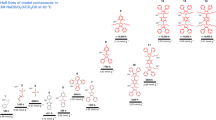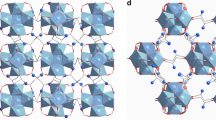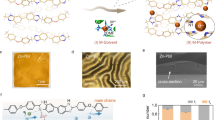Abstract
A novel proton conductor has been designed by the surface immobilization of protonated polyimidazolium monolayer on titanate nanotubes (TiNTs) through a polymer brush strategy. 2,2′-Azobis(2-methylpropionitrile) (AIBN)-type initiators are first attached to TiNTs followed by a free radical polymerization of protonated 1-vinylimidazole (VyImBF4) on the surface. The chemical structure of the resulting poly(VyImBF4)-modified TiNTs is verified by Fourier transform infrared (FTIR) and X-ray photoelectron spectroscopy (XPS). TGA curve indicates their good thermal stability. The maximum proton conductivity achieves 6.74 × 10−4 S cm−1 at 200 °C under dry condition and 3.60 × 10−2 S cm−1 at 120 °C under 100% humidity, respectively, when the polymerization is carried out under a polymerization time of 3 h and an immobilized initiator concentration of approximately 42.4 mmol L−1. The proposed preparation of poly(VyImBF4)-modified TiNTs would give a new idea for the design of other ion conductors.









Similar content being viewed by others
References
Kim SY, Kim S, Park MJ (2010) Enhanced proton transport in nanostructured polymer electrolyte/ionic liquid membranes under water-free conditions. Nat Commun 1:88
Goswami S, Dutta A (2013) Conductivity studies of plasticized proton conducting PVA-PVIM blend doped with NH4BF4. Ionics 19:1125–1134
Zhang H, Shen PK (2012) Advances in the high performance polymer electrolyte membranes for fuel cells. Chem Soc Rev 41:2382–2394
Wu HY, Saikia D, Lin CP, Wu FS, Fey GTK, Kao HM (2010) Synthesis, structure characterization and ionic conductivity of star-branched organic-inorganic hybrid electrolytes based on cyanuric chloride, diamine-capped poly(oxyalkylene) and alkoxysilane. Polymer 51:4351–4361
Druger SD, Nitzan A, Ratner MA (1983) Dynamic bond percolation theory: a microscopic model for diffusion in dynamically disordered systems. I Definition and one-dimensional case. J Chem Phys 79:3133–3142
He R, Kyu T (2016) Effect of plasticization on ionic conductivity enhancement in relation to glass transition temperature of crosslinked polymer electrolyte membranes. Macromolecules 49:5637–5648
Pitawala HMJC, Dissanayake MAKL, Seneviratne VA (2007) Combined effect of Al2O3 nano-fillers and EC plasticizer on ionic conductivity enhancement in the solid polymer electrolyte (PEO)9LiTf. Solid State Ion 178:885–888
Liu W, Liu N, Sun J, Hsu PC, Li Y, Lee HW, Cui Y (2015) Ionic conductivity enhancement of polymer electrolytes with ceramic nanowire fillers. Nano Lett 15:2740–2745
Li K, Ye G, Pan J, Zhang H, Pan M (2010) Self-assembled Nafion®/metal oxide nanoparticles hybrid proton exchange membranes. J Membr Sci 347:26–31
Han H, Li HQ, Liu M, Xu L, Xu J, Wang S, Ni H, Wang Z (2017) Effect of “bridge” on the performance of organic-inorganic crosslinked hybrid proton exchange membranes via KH550. J Power Sources 340:126–138
Amiinu IS, Li W, Wang G, Tu Z, Tang H, Pan M, Zhang H (2015) Toward anhydrous proton conductivity based on imidazole functionalized mesoporous silica/Nafion composite membranes. Electrochim Acta 160:185–194
Jalani NH, Dunn K, Datta R (2005) Synthesis and characterization of Nafion®-MO2 (M = Zr, Si, Ti) nanoparticle membranes for higher temperature PEM fuel cells. Electrochim Acta 51:553–560
Li Q, Xiao C, Li W, Zhang H, Chen F, Fang P, Pan M (2010) Enhanced proton conductivity of polymer electrolyte membrane doped with titanate nanotubes. Colloid Polym Sci 288:1369–1374
Yamada M, Wei M, Honma I, Zhou H (2006) One-dimensional proton conductor under high vapor pressure condition employing titanate nanotube. Electrochem Commun 8:1549–1552
Li Q, Xiao C, Zhang H, Chen F, Fang P, Pan M (2011) Polymer electrolyte membranes containing titanate nanotubes for elevated temperature fuel cells under low relative humidity. J Power Sources 196:8250–8256
Jothi PR, Dharmalingam S (2014) An efficient proton conducting electrolyte membrane for high temperature fuel cell in aqueous-free medium. J Membr Sci 450:389–396
Kreuer KD, Fuchs A, Ise M, Spaeth M, Maier J (1998) Imidazole and pyrazole-based proton conducting polymers and liquids. Electrochim Acta 43:1281–1288
Mamlouk M, Ocon P, Scott K (2014) Preparation and characterization of polybenzimidazole/diethylamine hydrogen sulphate for medium temperature proton exchange membrane fuel cells. J Power Source 245:915–926
Erdemi H, Akbey Ü, Meyer WH (2010) Conductivity behavior and solid state NMR investigation of imidazolium-based polymeric ionic liquids. Solid State Ion 181:1586–1595
Scharfenberger G, Meyer WH, Wegner G, Schuster M, Kreuer KD, Maier J (2006) Anhydrous polymeric proton conductors based on imidazole functionalized polysiloxane. Fuel Cells 6:237–250
Díaz M, Ortiz A, Ortiz I (2014) Progress in the use of ionic liquids as electrolyte membranes in fuel cells. J Membr Sci 469:379–396
Evans CM, Sanoja GE, Popere BC, Segalman RA (2016) Anhydrous proton transport in polymerized ionic liquid block copolymers: roles of block length, ionic content, and confinement. Macromolecules 49:395–404
Fan F, Wang Y, Hong T, Heres MF, Saito T, Sokolov AP (2015) Ion conduction in polymerized ionic liquids with different pendant groups. Macromolecules 48:4461–4470
Schneider Y, Modestino MA, McCulloch BL, Hoarfrost ML, Hess RW, Segalman RA (2013) Ionic conduction in nanostructured membranes based on polymerized protic ionic liquids. Macromolecules 46:1543–1548
Feng J, Huang Y, Tu Z, Zhang H, Pan M, Tang H (2014) Proton conduction of polyAMPS brushes on titanate nanotubes. Sci Rep 4:6225
Prucker O, Ruhe J (1998) Synthesis of poly(styrene) monolayers attached to high surface area silica gels through self-assembled monolayers of azo initiators. Macromolecules 31:592–601
Zhang H, Ruhe J (2005) Swelling of poly(methacrylic acid) brushes: influence of monovalent salts in the environment. Macromolecules 38:4855–4860
Hirao M, Ito K, Ohno H (2000) Preparation and polymerization of new organic molten salts; N-alkylimidazolium salt derivatives. Electrochim Acta 45:1291–1294
Sun X, Li Y (2003) Synthesis and characterization of ion-exchangeable titanate nanotubes. Chem Eur J 9:2229–2238
Ye Y, Elabd YA (2011) Anion exchanged polymerized ionic liquids: high free volume single ion conductors. Polymer 52:1309–1317
Li W, Liang X, Niu H, Tu Z, Feng J, Pan M, Zhang H (2014) Decorating titanate nanotubes with protonated 1,2,4-triazole moieties for anhydrous proton conduction. J Colloid Interface Sci 432:26–30
Shaplov AS, Marcilla R, Mecerreyes D (2015) Recent advances in innovative polymer electrolytes based on poly(ionic liquid)s. Electrochim Acta 175:18–34
Herz HG, Kreuer KD, Maier J, Scharfenberger G, Schuster MFH, Meyer WH (2003) New fully polymeric proton solvents with high proton mobility. Electrochim Acta 48:2165–2171
Schuster M, Meyer WH, Wegner G, Herz HG, Ise M, Schuster M, Kreuer KD, Maier J (2001) Proton mobility in oligomer-bound proton solvents: imidazole immobilization via flexible spacers. Solid State Ion 145:85–92
Acknowledgements
This work was supported by the National Science Foundation of China [No. 21576216] and the Scientific Research Foundation of Guangxi University [No. XGZ170232].
Author information
Authors and Affiliations
Corresponding authors
Ethics declarations
Conflict of interest
The authors declare that they have no conflict of interest.
Rights and permissions
About this article
Cite this article
Zhang, F., Li, W., Zheng, X. et al. Surface attachment of protonated polyimidazolium monolayer on titanate nanotubes as a novel proton conductor. J Mater Sci 53, 15784–15794 (2018). https://doi.org/10.1007/s10853-018-2739-9
Received:
Accepted:
Published:
Issue Date:
DOI: https://doi.org/10.1007/s10853-018-2739-9




